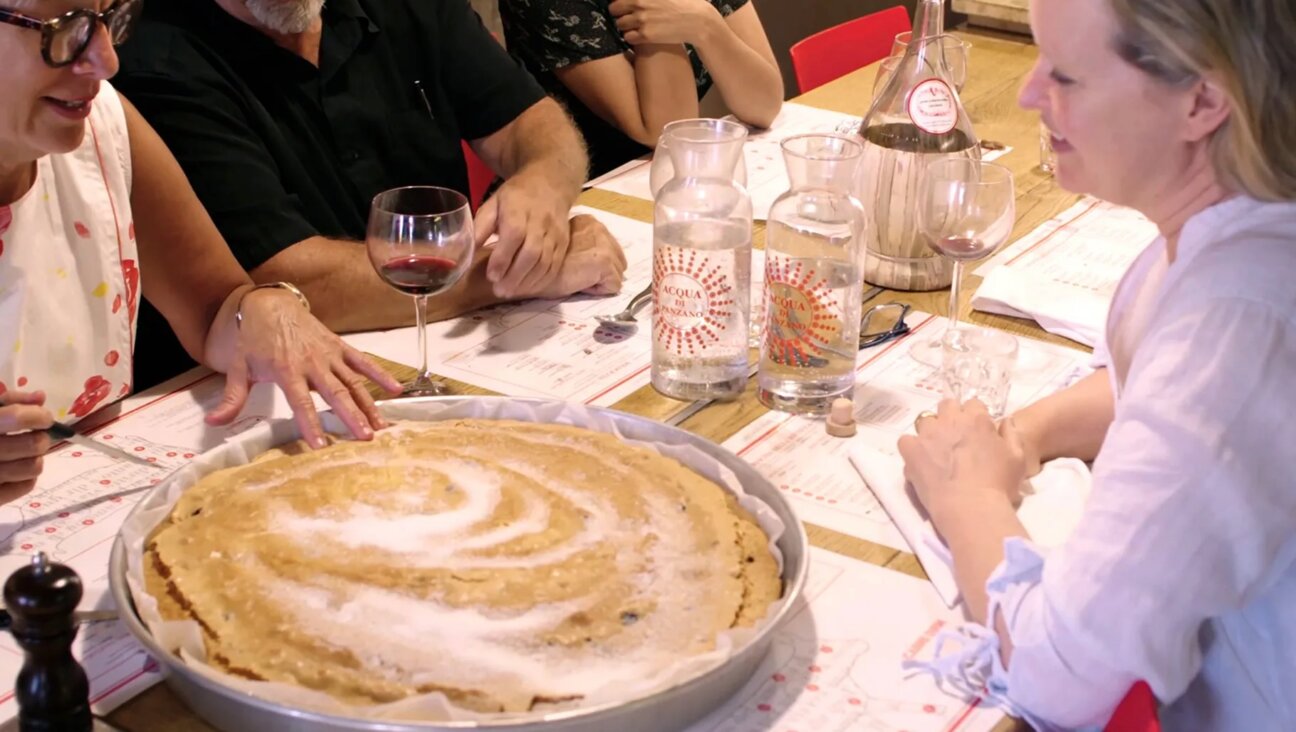Vegan Grilled Garden Vegetable Lasagna With Puttanesca Sauce

Graphic by Angelie Zaslavsky
Serves 8-12
Zucchini can be watery and lacking in flavor or texture, so when Scot proposed putting a vegetable lasagna that featured zucchini on the menu, I was skeptical. But the flavors he builds into this lasagna are extraordinary. It’s an Italian flag on a plate — green pesto, white almond ricotta and rich red puttanesca sauce. The grilled eggplant, roasted red bell pepper, and zucchini that intermingle with the pasta layers cut down on carbs and calories and add nutrition.
4 red or yellow bell peppers (about ¾ pound)
4 large zucchini (1½ pounds), sliced on a diagonal about ¼-inch thick
1 large Italian eggplant (about 1 pound), sliced into ¼-inch-thick rounds
1 large onion (about ½ pound), sliced into ¼-inch-thick rounds
¼ cup extra-virgin olive oil, plus more for coating the grill pan
6 large fresh basil leaves, chopped
3 fresh thyme sprigs, leaves stripped from the stems and chopped
2 garlic cloves, minced
1 shallot, minced
Kosher salt and freshly ground black pepper
Herb Ricotta (recipe follows)
2 cups Basil Pesto (recipe follows)
Puttanesca Sauce (recipe follows)
1 pound lasagna noodles, cooked in boiling salted water just until al dente, drained, and rinsed
10 ounces soy mozzarella, preferably Follow Your Heart Vegan Gourmet, shredded (4 cups)
1) Put each pepper directly on a gas burner over high heat and char, turning periodically with tongs, until the skin is wrinkled and blistered on all sides, about 10 minutes. Alternatively, you can roast the peppers using a broiler, turning them occasionally. Put the peppers into a bowl, cover with plastic wrap and let them steam for about 10 minutes to loosen the skins.
2) Pull out the cores of the peppers and remove the seeds. Pull off and discard the blackened skin. Dip your fingers in water as you work to keep the charred bits from sticking. Cut the roasted peppers into ½-inch-wide strips and put in a large mixing bowl, along with any juices that have collected. Add the sliced zucchini, eggplant and onion, tossing to combine.
3) Combine the oil, basil, thyme, garlic and shallot in a small bowl or measuring cup, season with salt and pepper, and whisk to blend. Pour the marinade over the vegetables, tossing to coat evenly. Set aside for 10 minutes so the vegetables can soak up the flavor.
4) Preheat an outdoor grill and coat with oil, or coat a grill pan with oil and put over medium-high heat. Alternatively, preheat the broiler.
5) Arrange the peppers, zucchini, eggplant and onion on the grill or grill pan (if using a grill pan, you will have to do this in batches) and grill, turning the vegetables once, until they are tender and lightly browned and have released most of their moisture, about 5 minutes per side. Or, if using the broiler, arrange the vegetables in a single layer on two nonstick baking sheets and broil in 2 batches. Set the vegetables aside.
6) Mix together the herb ricotta and 1 cup of the basil pesto in a large bowl. Season with salt and pepper.
7) Once you have the sauce ready, the vegetables grilled, and the filling made, you can start assembling the lasagna. Preheat the oven to 375°F.
8) Ladle about 1 cup of the sauce into a 9-by-13-inch baking dish, to just cover the bottom. Slightly overlap 6 lasagna noodles crosswise so they completely cover the bottom of the dish, with no gaps. Top the noodles with one-third of the ricotta-pesto mixture, spreading it evenly with a rubber spatula. Sprinkle 1 cup of the soy mozzarella over the ricotta. Shingle one-third of the roasted peppers, zucchini, eggplant, and onion in an even layer on top. Repeat the process, layering sauce, lasagna noodles, ricotta-pesto, soy mozzarella, and vegetables 2 more times. Finally, top with the remaining 6 lasagna noodles and sauce.
9) Cover the lasagna with aluminum foil and bake for 45 minutes to 1 hour, until bubbly. Remove the foil and top the lasagna with the remaining 1 cup soy mozzarella. Bake for another 5 minutes, or until the cheese has melted. Allow the lasagna to cool for 10 minutes before cutting into 8 squares.
10) To serve: Divide the remaining 1 cup pesto among eight to twelve plates, spreading it out with the back of a spoon. Set a lasagna square on top.
Herb Ricotta
Makes about 4 cups
We add fresh herbs to the almond ricotta to bring a little something extra to the pasta filling. We also use the herb ricotta filling for cappellacci.
4 cups Kite Hill almond ricotta
6 fresh basil leaves, finely chopped
4 fresh flat-leaf parsley leaves, finely chopped
3 garlic cloves, minced
1 shallot, minced
Kosher salt and freshly ground black pepper
1) Mash together the almond ricotta, basil, parsley, garlic, and shallot in a bowl. Season with salt and pepper. The ricotta can be prepared in advance, covered, and refrigerated for up to 5 days before using it as a pasta filling; leftovers keep in the refrigerator for up to 5 days.
Basil Pesto
Makes 1 cup
Pesto, among the best-known sauces to come out of Italy, is simple to make, requires no cooking and has only a few ingredients. Yet it adds the most delicious pop of color and flavor to pastas, soups and roasted vegetables. When most of us think of pesto, we think of basil and pine nuts, but you can change it up and use other ingredients you have on hand, like arugula and walnuts, or sun-dried tomatoes and almonds. The pesto can be stored covered in the refrigerator for 1 day; freezing is not ideal, because it will change color and make the pesto very dark.
2 cups fresh basil leaves
½ cup fresh flat-leaf parsley leaves
¼ cup nutritional yeast flakes (see Note)
¼ cup pine nuts, toasted
4 garlic cloves, smashed
½ teaspoon kosher salt
¼ teaspoon freshly ground black pepper
¼ teaspoon red pepper flakes
½ cup extra-virgin olive oil
1) Combine the basil, parsley, nutritional yeast flakes, nuts, garlic, salt, black pepper and red pepper flakes in a food processor and pulse until a paste forms, pushing down the basil and parsley as needed. With the motor running, pour in the oil in a steady stream, making sure it directly hits the blade (this is the best way to distribute the oil and emulsify it evenly and quickly). Transfer to a container. If you’re not going to use the pesto immediately, press a piece of plastic wrap against the surface to keep it from oxidizing.
Note on Nutritional Yeast Flakes
Nutritional yeast may not sound like the most appetizing ingredient, but it has a cheesy, nutty, savory quality that gives any dish extra oomph. Just a tablespoon or two adds a creamy, salty richness to dips, soups and sauces. Look for nutritional yeast flakes in the supplement section of the market or health food store. Be sure to select flakes instead of granules, which will deliver a bit of texture to whatever you add them to.
Puttanesca Sauce
Makes 8 cups
Puttanesca is a robust old-school Italian red sauce made from pantry staples — olives, capers and red pepper flakes. Serve it with any of the pastas in this chapter. It can be made up to 3 days in advance and stored in an airtight container in the refrigerator.
¼ cup extra-virgin olive oil
6 garlic cloves, minced
2 shallots, finely chopped
1 teaspoon red pepper flakes
¼ cup dry white wine
2 tablespoons tomato paste
6 cups Scoty’s Marinara Sauce (recipe follows) or store-bought sauce
1 cup pitted Kalamata olives, halved lengthwise
1/3 cup capers, drained
8 fresh basil leaves, cut into chiffonade
Kosher salt and freshly ground black pepper
1) Put a medium pot over medium heat and add the oil. When the oil is hot, add the garlic, shallots, and red pepper flakes and cook, stirring, until the shallots are translucent, 2 to 3 minutes.
2) Pour in the wine and cook, stirring, for 1 to 2 minutes to evaporate some of the alcohol. Stir in the tomato paste and marinara sauce and bring to a simmer. Reduce the heat to medium-low, add the olives, capers and basil, and season with salt and black pepper. Gently simmer, stirring occasionally, until the sauce has thickened slightly, about 30 minutes.
Scoty’s Marinara Sauce
Makes 6 cups
If tomorrow was my last day on earth, I’d request a fresh piece of focaccia dunked in a vat of Scoty’s marinara for my last meal. A well-made marinara should be thick enough to cling to pasta and vegetables yet light and fresh enough to balance whatever it’s paired with. Cooked in under an hour, Scoty’s sauce is thick but not heavy. Grated carrot is the secret weapon, lending both its natural sweetness and texture.
Be sure to seek out canned San Marzano tomatoes, which are now available at most grocery stores. This Italian tomato variety is coveted for its low acidity, bright flavor and deep red color. This is the only marinara sauce you’ll ever need. We use it in Fig Caponata, Spiced Chickpeas, and Puttanesca Sauce, among other dishes.
Two 28-ounce cans whole tomatoes, preferably San Marzano
3 tablespoons extra-virgin olive oil
1 onion, finely chopped
4 garlic cloves, minced
1 carrot, finely grated (about ½ cup)
Kosher salt and freshly ground black pepper
½ teaspoon red pepper flakes
Pinch of baking soda
4 fresh basil leaves, chopped
1 tablespoon Earth Balance butter stick
1) Working in batches, put the tomatoes, along with their juice, in a food processor or blender and puree just until semi-smooth; you want a little bit of chunky texture.
2) Put a medium pot over medium heat and add the oil. When the oil is hot, add the onion, garlic and carrot, season with salt, black pepper and the red pepper flakes, and sauté until the vegetables are soft, about 10 minutes.
3) Add the pureed tomatoes, stirring to combine, and bring to a boil. Reduce the heat to medium-low and simmer, uncovered, until the sauce thickens, about 45 minutes. Season the sauce with more salt and black pepper, to taste. Remove from the heat, stir in the baking soda, making sure it dissolves, and add the basil and butter substitute.
Once cooled, the sauce can be refrigerated covered for up to 3 days or frozen for up to 2 months.
Related
Chef to Stars Shares Recipes in ‘Crossroads’
Warm Kale and Artichoke Dip
Excerpted from “Crossroads” by Tal Ronnen with Scot Jones. (Artisan Books). Copyright © 2015. Photographs by Lisa Romerein.
















